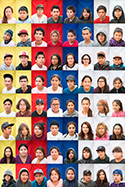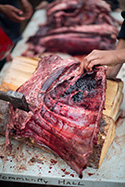Fort Albany First Nation, traditionally known as Peetabeck (loosely translated to ' the meandering river floods a pond in the springtime'), is a remote Indigenous First Nation community, one of over 600 in Canada. It is a reserve part of the Treaty 9 territory and is located on the western coast of James Bay in Northern Ontario, about 130 kilometers northwest of Moosonee. Fort Albany is a Cree community and home to many survivors of the notorious St. Anne’s Residential School, which closed in 1964, but stood till it was set ablaze in 1999.
The population in Fort Albany fluctuates at around 900 Albanians (self-identified residents of Fort Albany). The community is accessible only by air, water, and winter road. Like many First Nations reserves in Canada, Fort Albany is on simultaneous paths of recovery, re-discovery, and preservation. As key community members, including Elders, have begun to further explore and promote their traditional roots through ceremonies, hunting practices, language, cuisine, music and art, it has become imperative for them to share these practices with their youth. While dealing with the effects from past atrocities, Peetabeck is practicing a delicate, and sometimes divided, dance between the reclamation, acceptance, and rejection of both traditional and Western cultures.
In Fort Albany, like all societies, the youth are the future. And while they are full of potential, they are also the most vulnerable and impressionable. It is these young people, at times neglected, sometimes bored, or even abused, who face the most devastating challenges of a community severely affected by drugs, alcohol and what many refer to as the “suicide spirit”. It seems, in the experience of this photographer, that everyone in Fort Albany has a tragic story to share, whether it was a mother, a father, a son, a daughter, or an uncle or aunt. So many lives have been cut short. The trauma is intergenerational and is rooted in the long, dark history of travesties committed against First Nations in Canada, which include but are not limited to rape and physical abuse, endured by many of those who attended residential school.
How does a community overcome the pain? Community leaders see an opportunity to steer youth on a path of healing. Young leaders recognize many of the challenges they and their peers face. Continuous efforts are made to involve people in positive activities and reconnect them to the land and traditions that were destroyed by residential schools and other deplorable colonial activities of Canada’s past.
The intention of this work is to shed light on the daily lives of young Albanians and show that, although they face enormous challenges, there is much hope in their community.
Nick Kozak (b. 1982) is a freelance photojournalist whose current work is focused on the issues of community and identity, their inseparability and constant state of flux. He explores communities that are displaced, marginalized, and/or those carving out new social spaces out of necessity or a desire to redefine a collective identity. His curiosity is combined with a keen eye, innate sensitivity and desire for greater social awareness. By nurturing relationships with communities and placing a great importance on learning from the people he photographs, Nick is able to create intimate pictures that tell informative stories.
For more information, please contact Nick Kozak at: photo@nickkozak.com or visit: www.nickkozak.com
Interview with Nick Kozak here

























Socialize with Us: